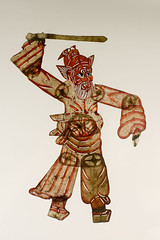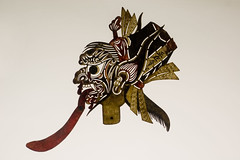It is rare nowadays to see nang talung shows being staged in Bangkok, but down south, in the
 Image by Sebastian Niedlich (Grabthar) via Flickr
Image by Sebastian Niedlich (Grabthar) via Flickr
Backstage, Suchart removes one of his ‘nang talung’ puppets from its woven bamboo container.
On family land close to his own home, Suchart Subsin, named a national artist because of the valuable contributions he has made to the field of folk performance, commissioned the construction of four two-storey, wooden houses as a nang talung museum.
On family land close to his own home, Suchart Subsin, named a national artist because of the valuable contributions he has made to the field of folk performance, commissioned the construction of four two-storey, wooden houses as a nang talung museum.
"I paid for it out of my own pocket because I wanted to preserve this important part of our cultural heritage," explained Suchart whom local residents affectionately address as loong (uncle).
A native of Nakhon Si Thammarat, he has been interested in nang talung from an early age. As a young man he used to put on puppet shows daily for one- or two-month stretches, often working up to eight hours a night. Back then, he said, he and his fellow puppeteers were much in demand, performing at pre-ordination parties, weddings, funerals and temple fairs. During his long career he has worked all over Thailand and is particularly proud of the time he entertained HM the King. He has also taken his puppets abroad for performances in Japan, Germany and France and is scheduled to put on a show in Australia next year.
Nang talung probably originated in India, he said, and in its early days in Siam the stories were  all based on the Ramayana epic. Elements of local folklore were later incorporated into the plots and master puppeteers also created typically Thai characters which would appeal to audiences here.
all based on the Ramayana epic. Elements of local folklore were later incorporated into the plots and master puppeteers also created typically Thai characters which would appeal to audiences here.
 all based on the Ramayana epic. Elements of local folklore were later incorporated into the plots and master puppeteers also created typically Thai characters which would appeal to audiences here.
all based on the Ramayana epic. Elements of local folklore were later incorporated into the plots and master puppeteers also created typically Thai characters which would appeal to audiences here. "The art of nang talung is all about skilful storytelling. A puppeteer needs to have a good sense of humour in order to make the tale enjoyable and keep the audience's attention right to the very end of the show."
The major difference between nang talung and nang yai, the other style of shadow puppet theatre popular in Thailand, is the size and intricacy of the figures. The leatherwork for nang talung puppets is not as detailed and they are much smaller so one person can manipulate all the characters (up to 30) needed to tell a story. The elaborate nang yai puppets are so big and cumbersome that each requires its own personal puppeteer. The limbs and jaws of nang talung puppets are articulated so they can be made to appear to speak and move in a much more lifelike fashion than their inflexible nang yai counterparts.
 Housed in four traditional houses, the shadow-puppet museum has a simple, rustic look.
Housed in four traditional houses, the shadow-puppet museum has a simple, rustic look.Now 75, Suchart is still hale and hearty, energetically manipulating his cast of characters and putting on whichever voice - young, old, male or female - is appropriate for each. His scripts invariably contain witty references to current affairs, politics and social issues and he keeps the look right up to date by adding new characters from time to time. His latest creation is a woman who can change in a flash from being a timid southerner in typically modest garb to a supremely self-confident urban trendy sporting jeans, skimpy tank top and mobile phone.
Suchart performs sitting cross-legged on the floor of the stage, concealed behind a large piece of white cloth. This screen is illuminated from behind by a simple household lightbulb. His only
 Image by Sebastian Niedlich (Grabthar) via Flickr
Image by Sebastian Niedlich (Grabthar) via Flickr
National Artist Suchart Subsin
He always performs live and says what he most enjoys is getting his audience to laugh. "My favourite characters are two professional comedians called Kaew and Thong. I'm very fond of them because I'm able to crack jokes on their behalf!"
The audience certainly seemed to appreciate his sense of humour during the short demonstration show I attended recently; we were having so much fun that the 20 minutes simply flew by!
Afterwards we were encouraged to visit the museum where the exhibits include a wide variety of nang talung figures, including several 150-year-old antiques, plus puppets used in other parts of the Kingdom (like the nang phramothai figures of the Northeast) and puppets from Turkey, India, China and Indonesia. Also on display are instruments used to provide the traditional musical accompaniment for nang talung shows such as long drums, gongs and the sor-u (alto fiddle).
"It gladdens my heart to know that people are still interested in nang talung," Suchart confided as I took my leave.
Demonstration of leather tooling.




No comments:
Post a Comment